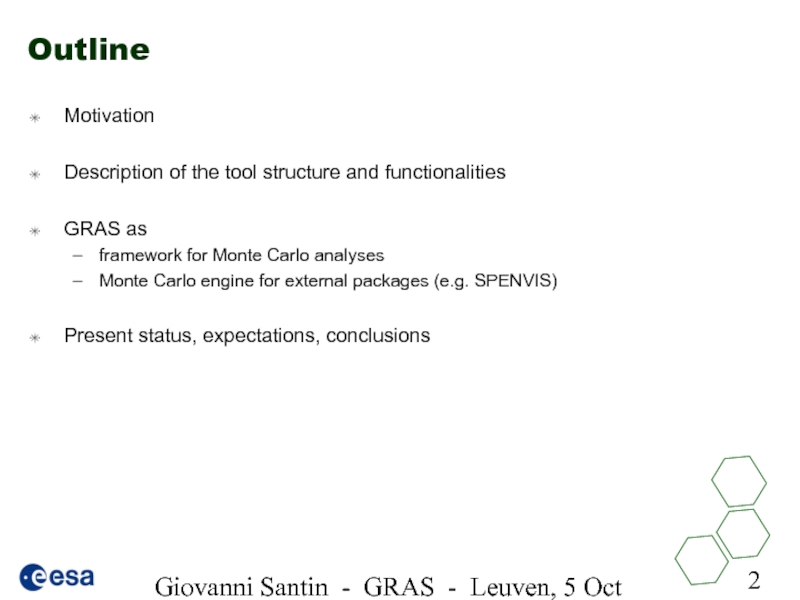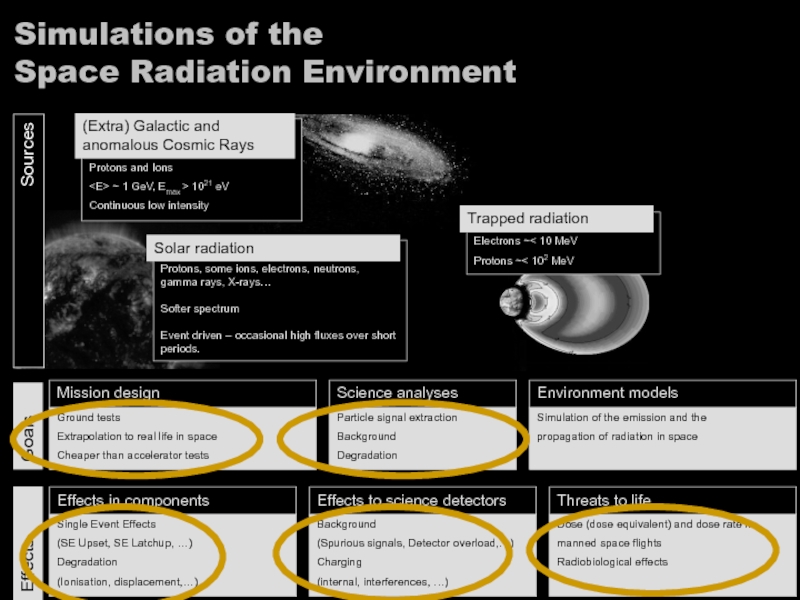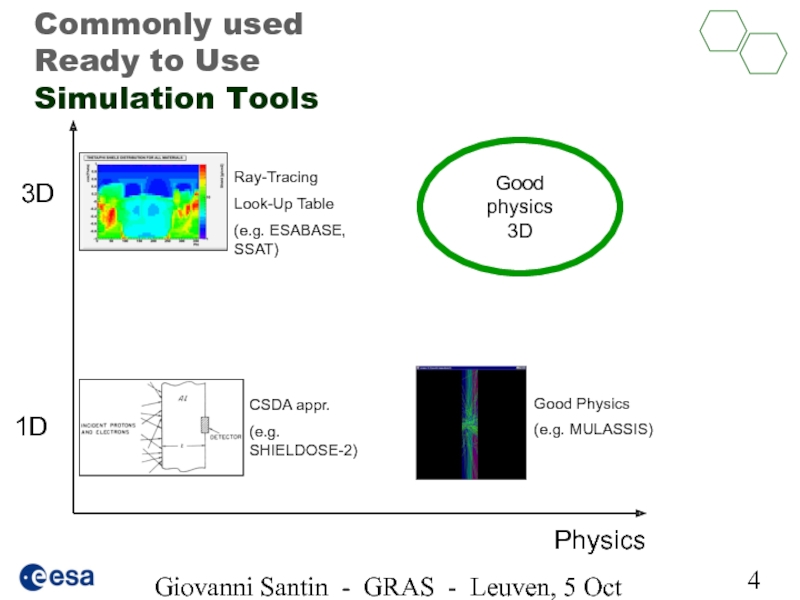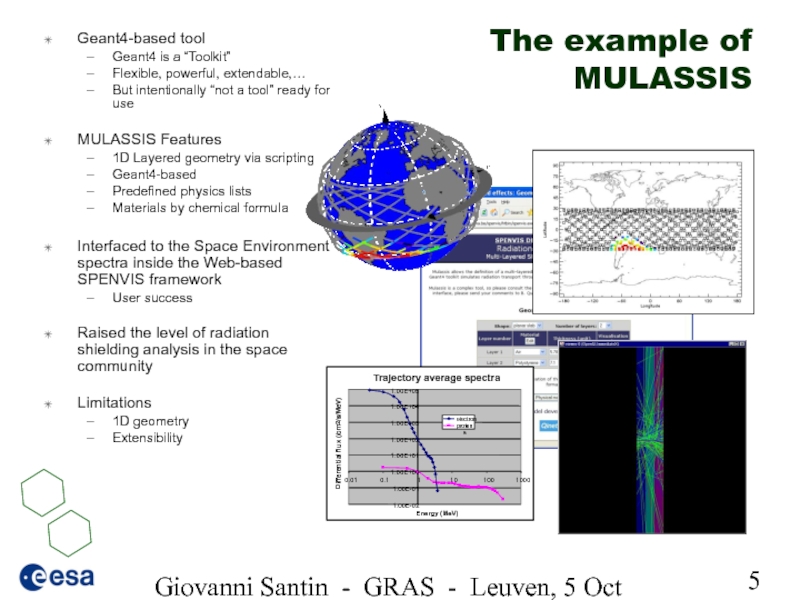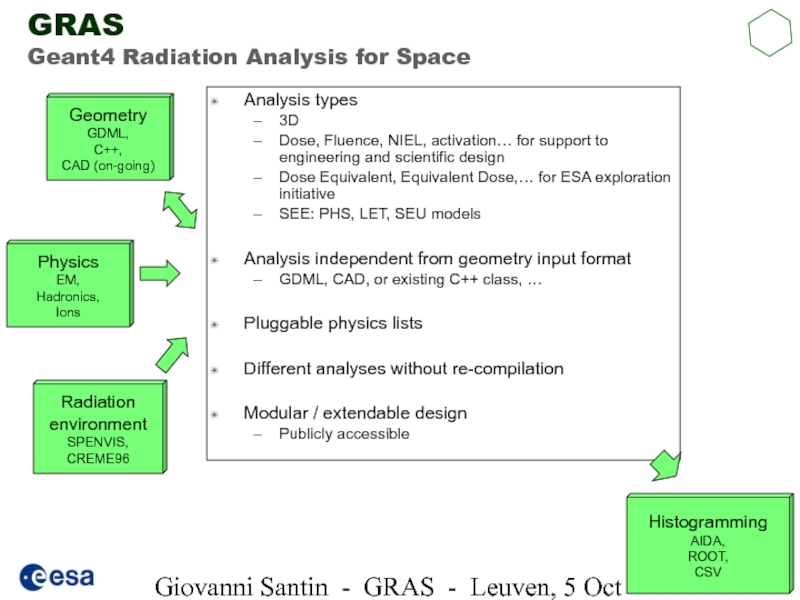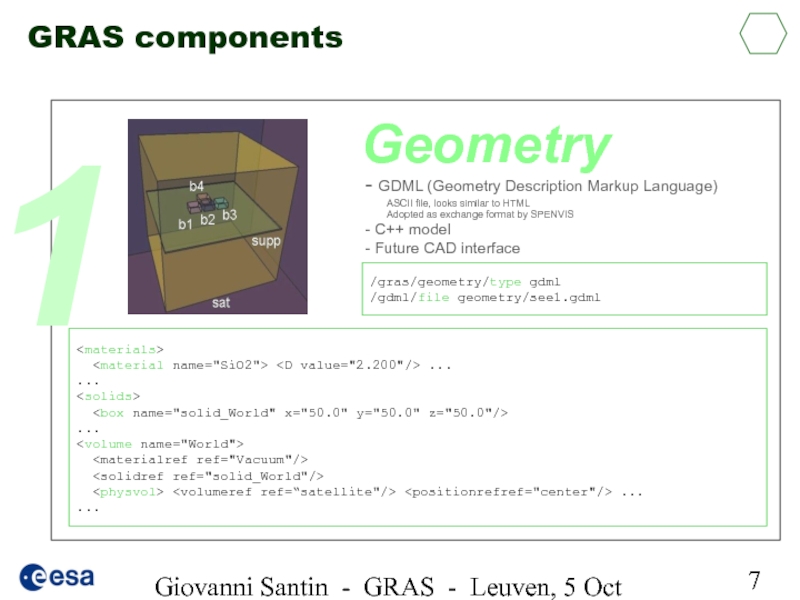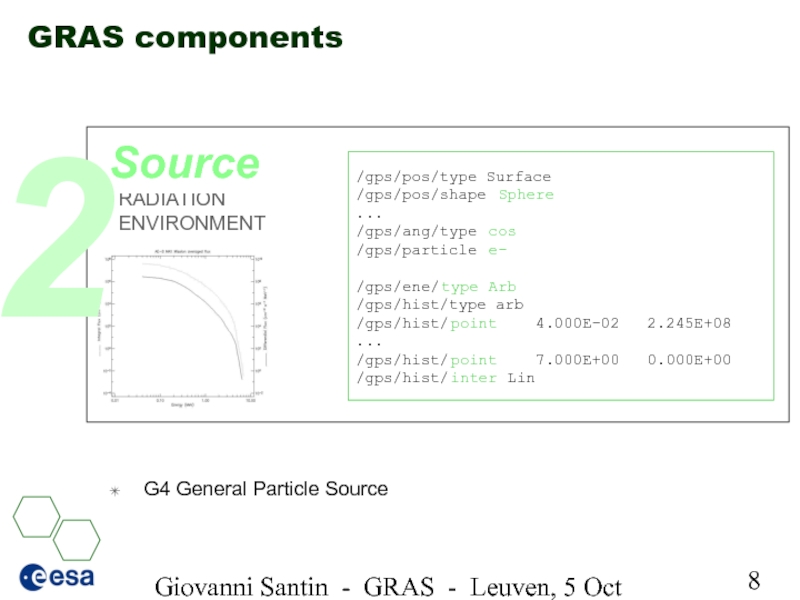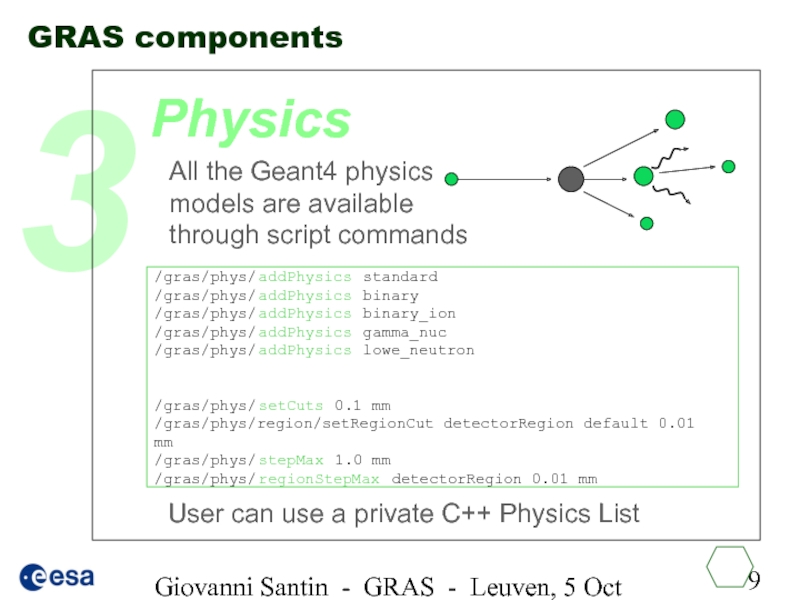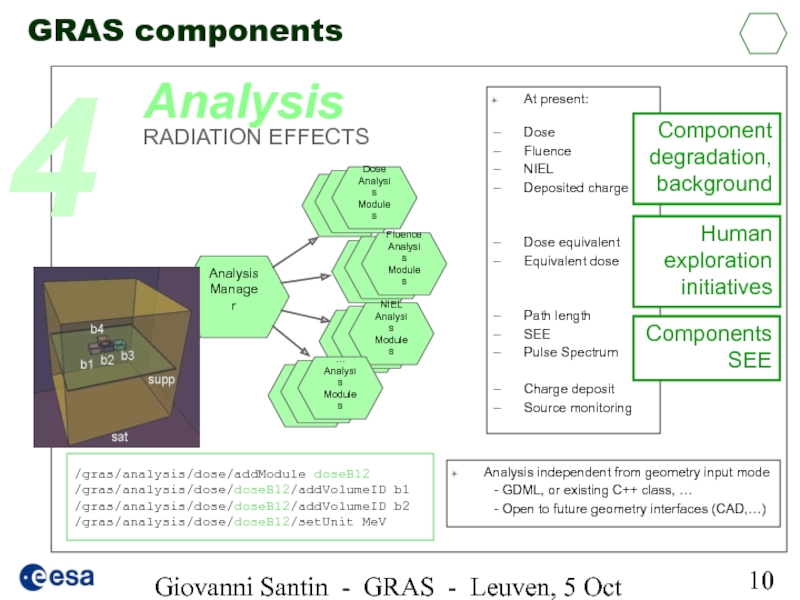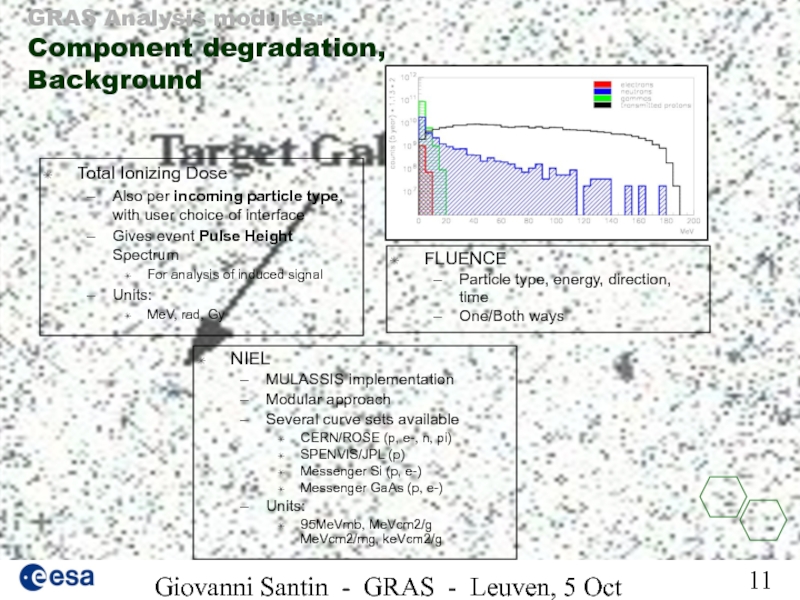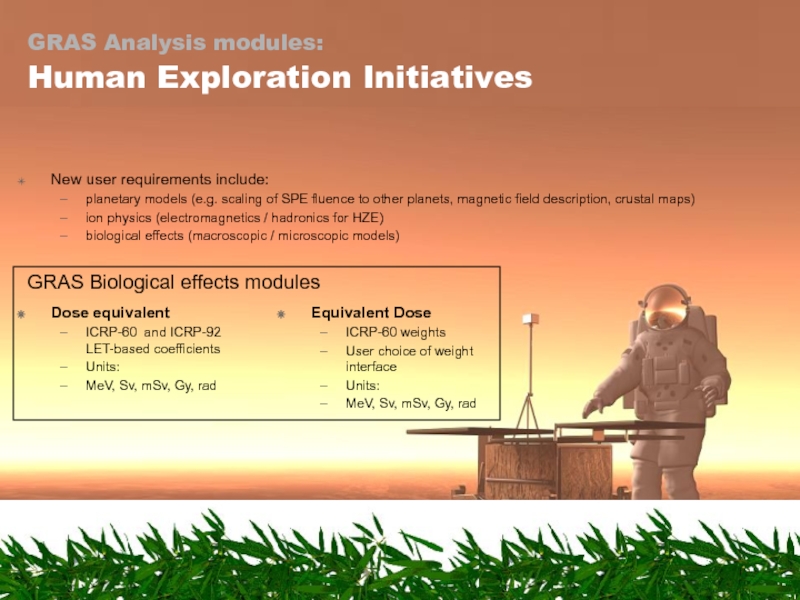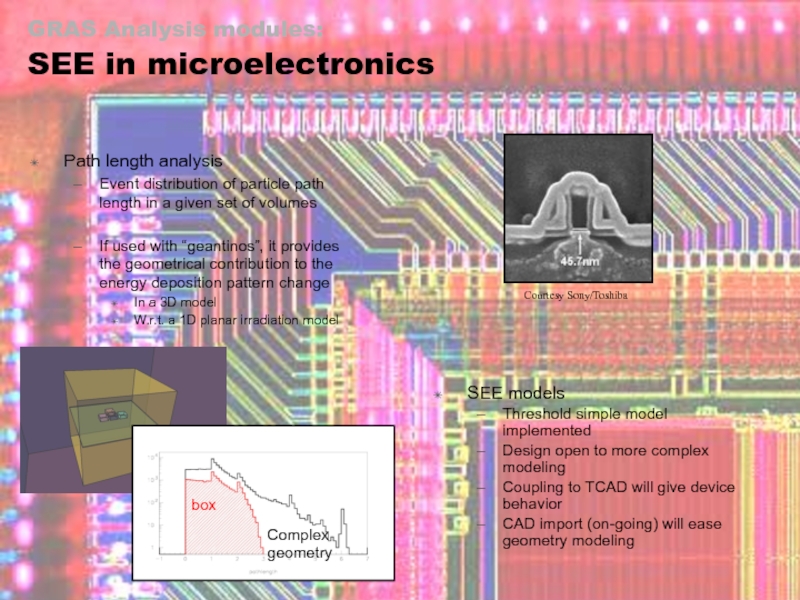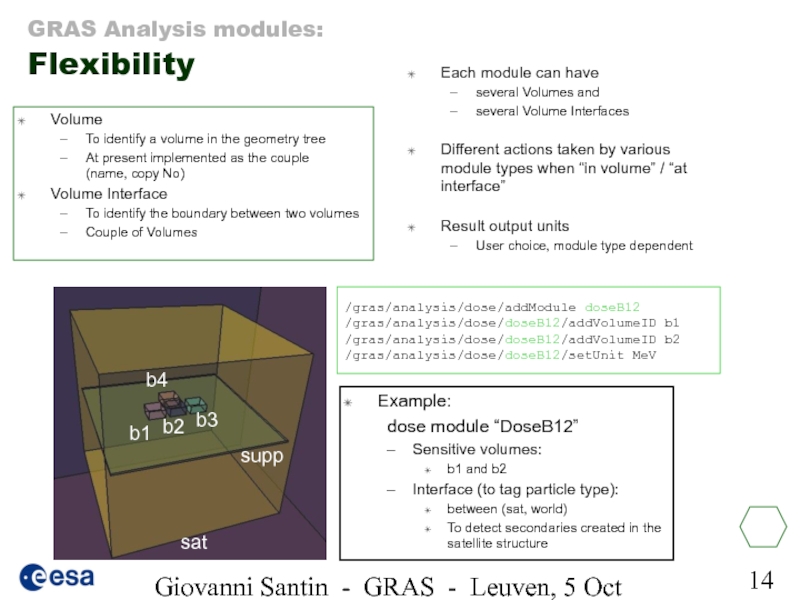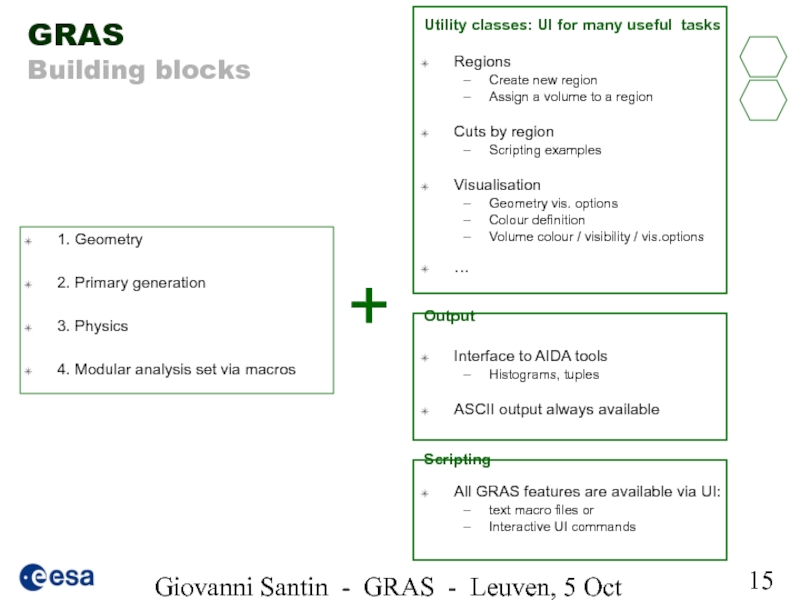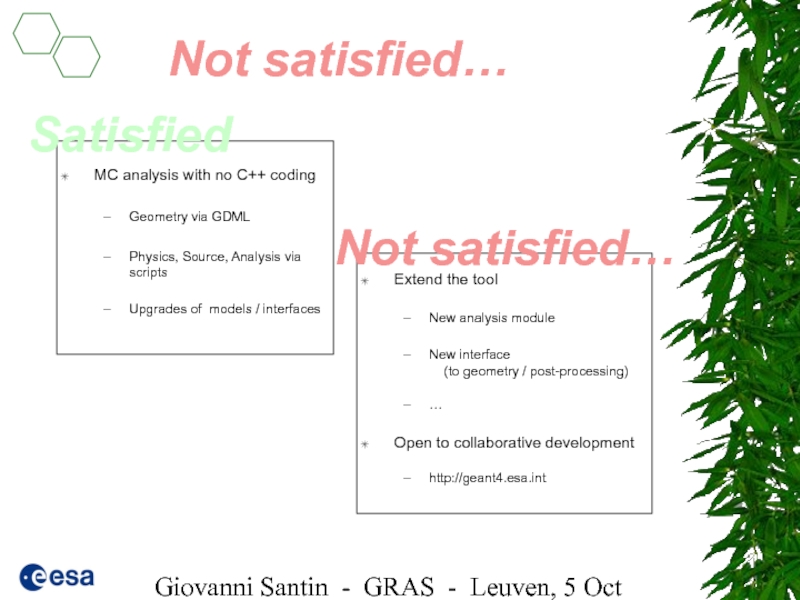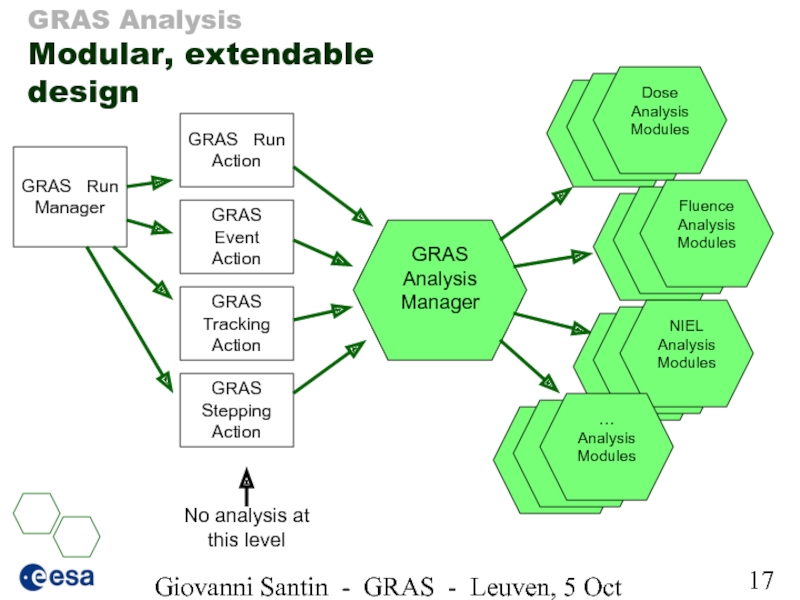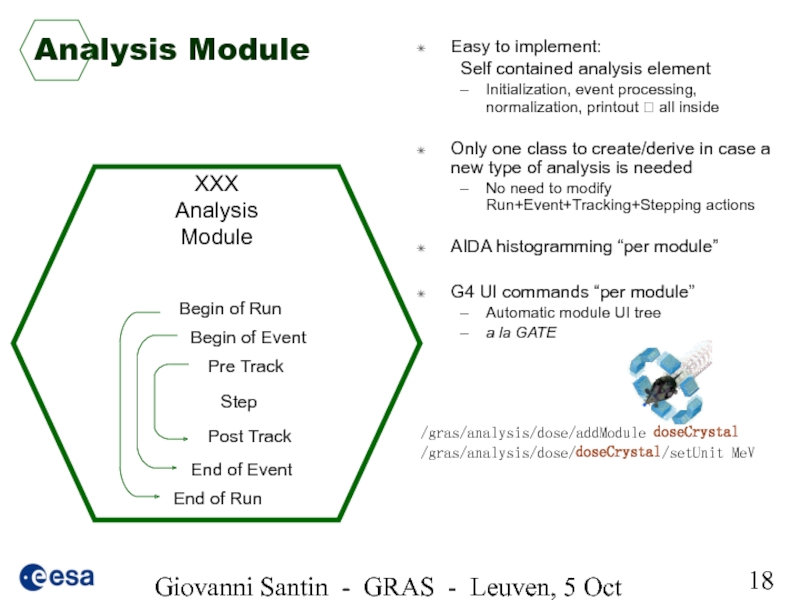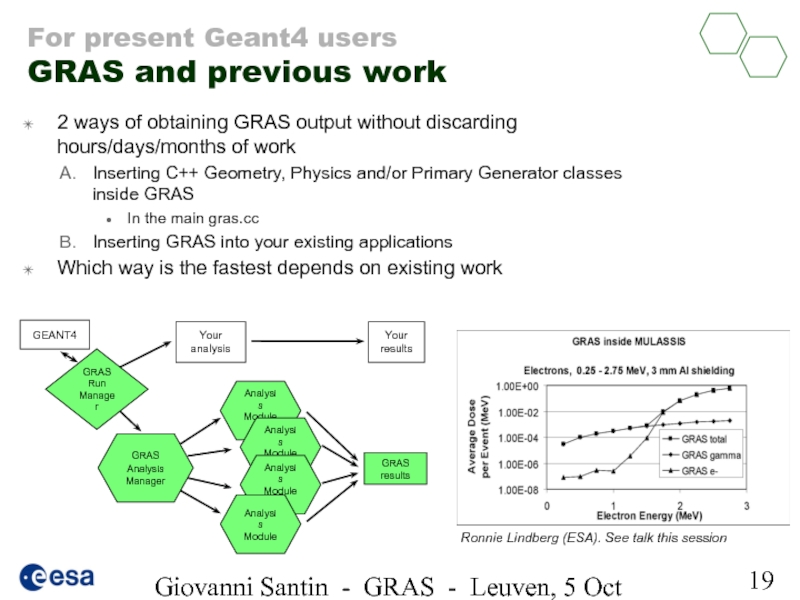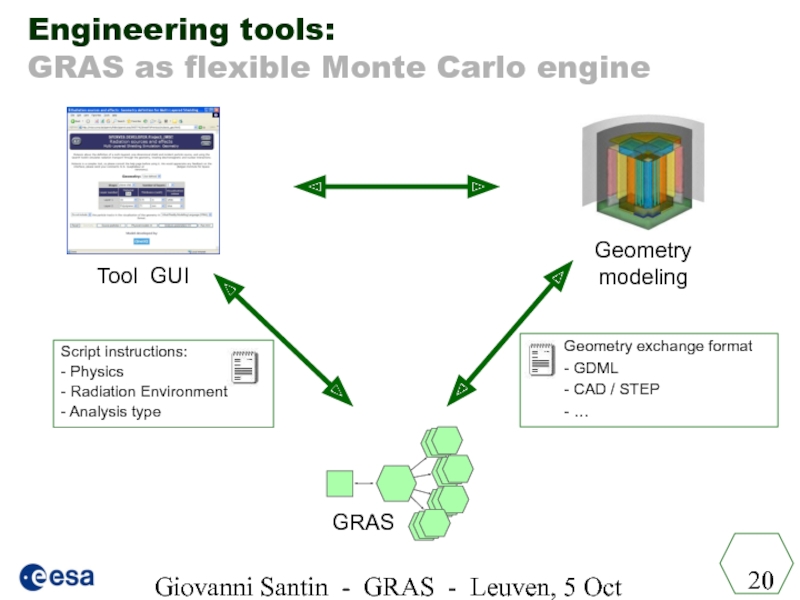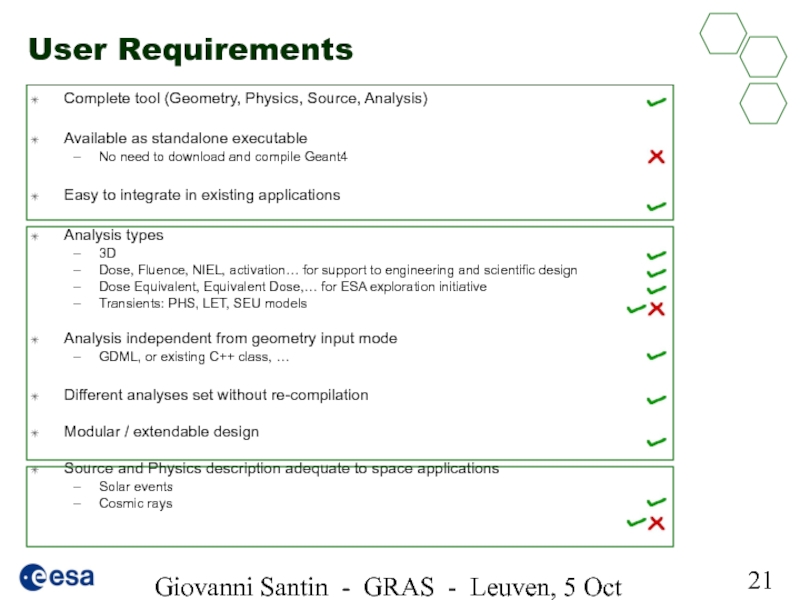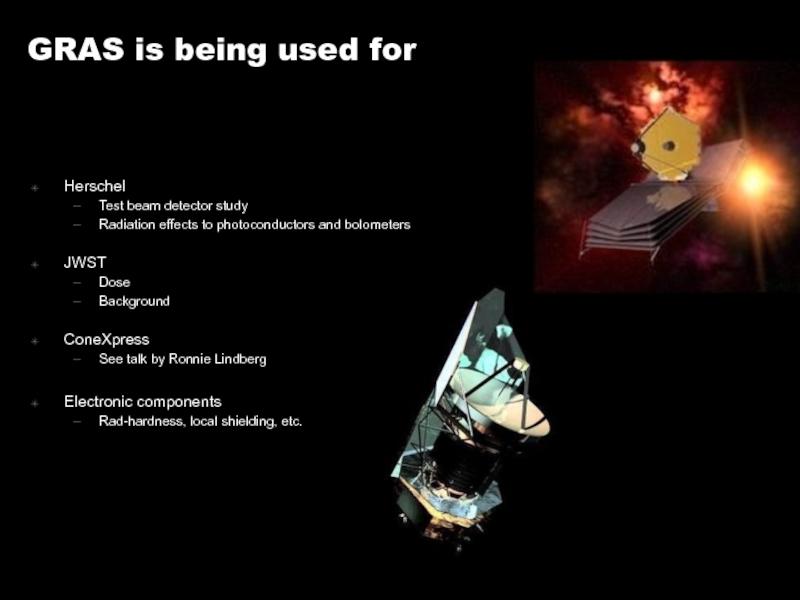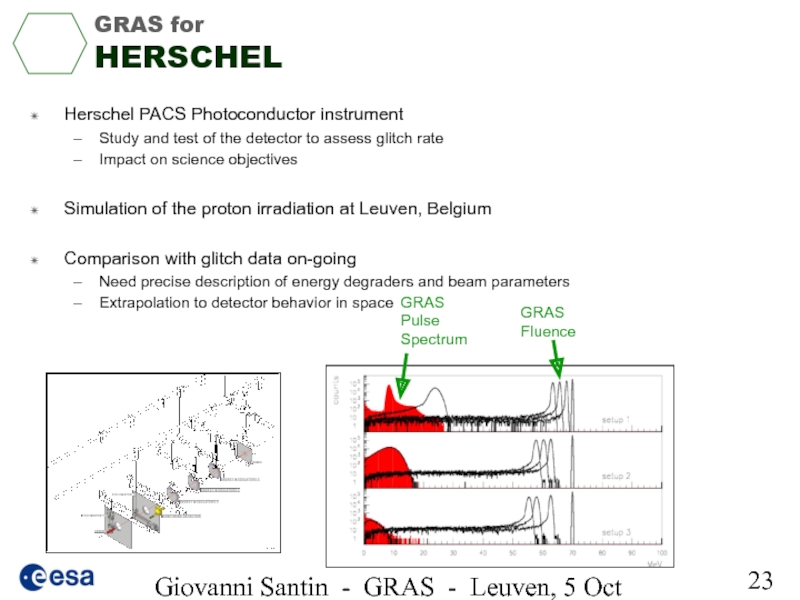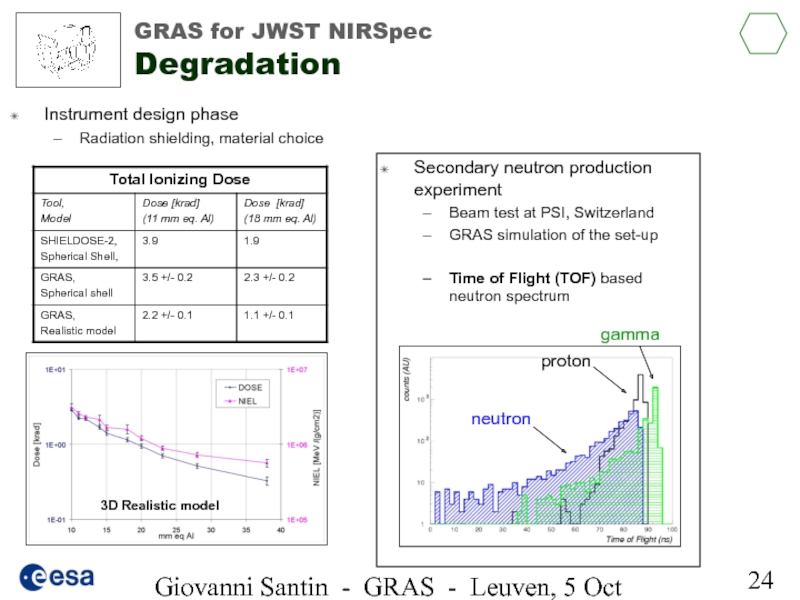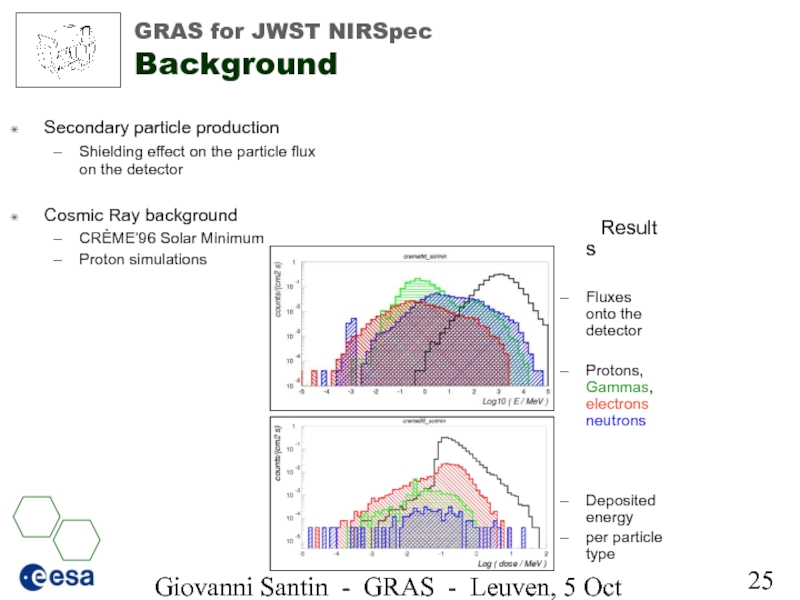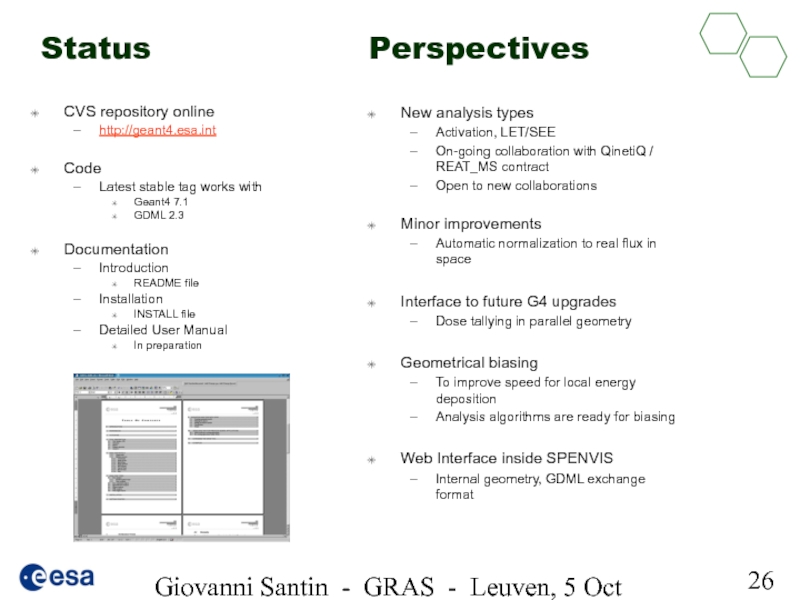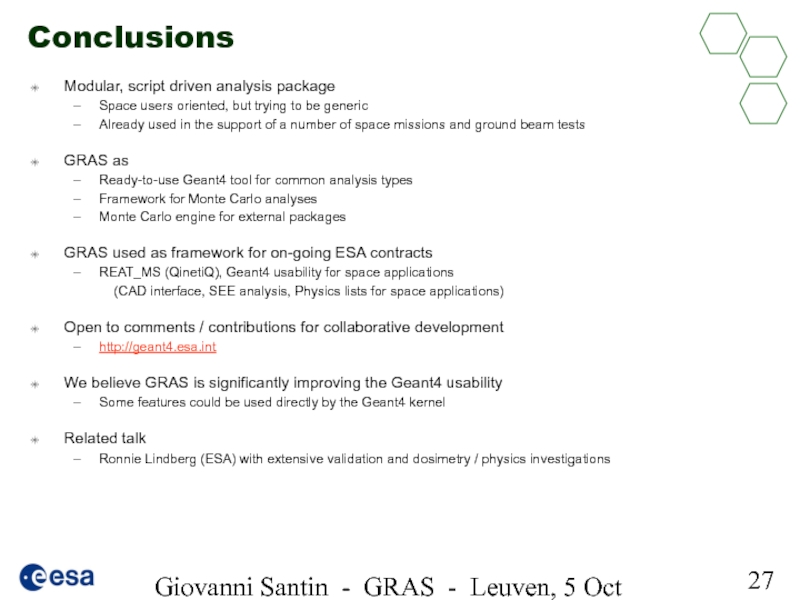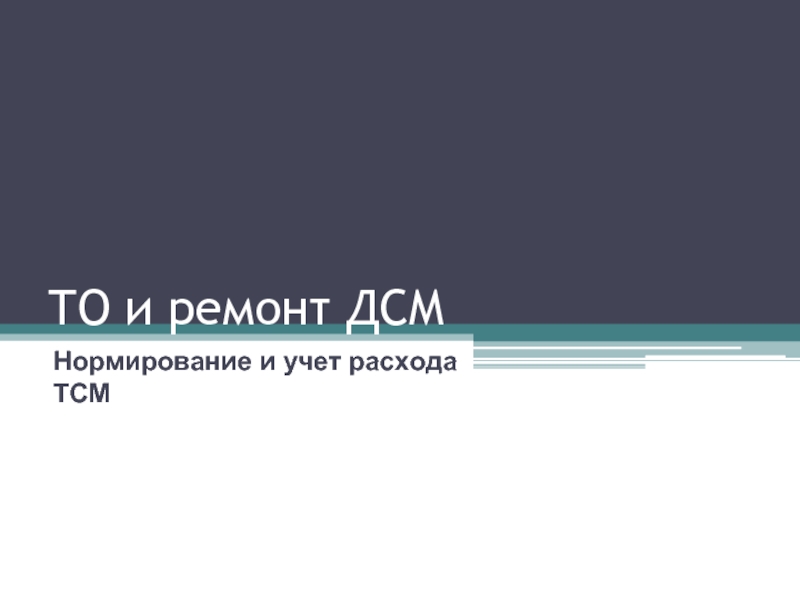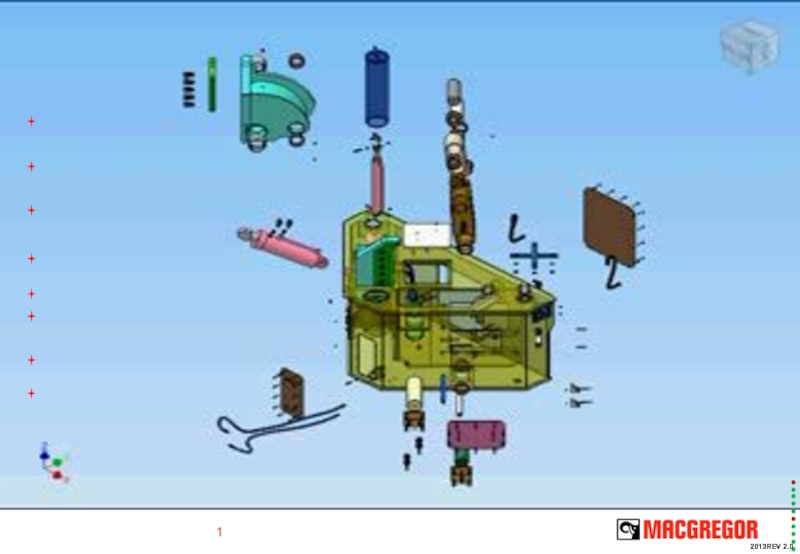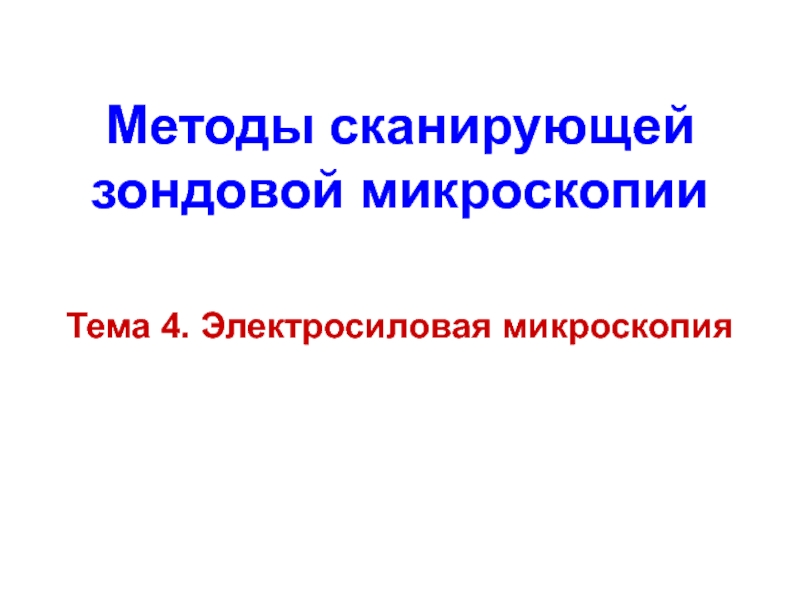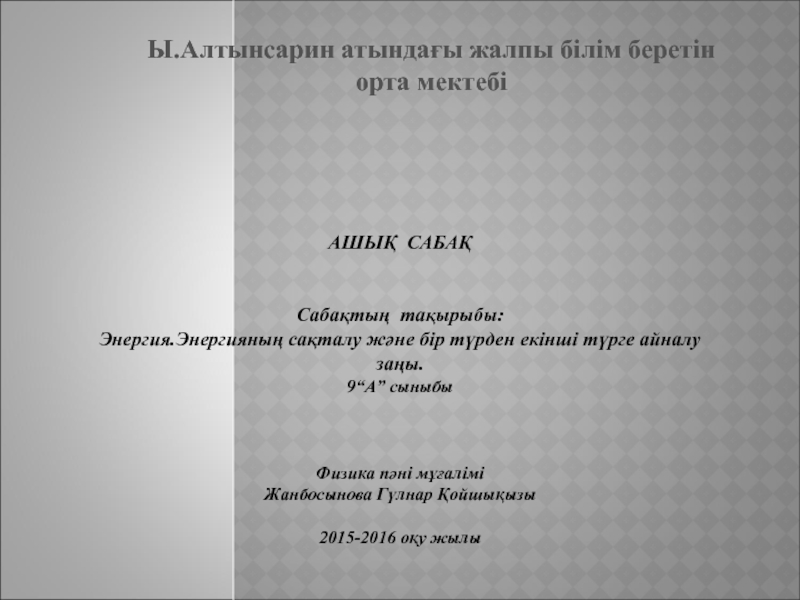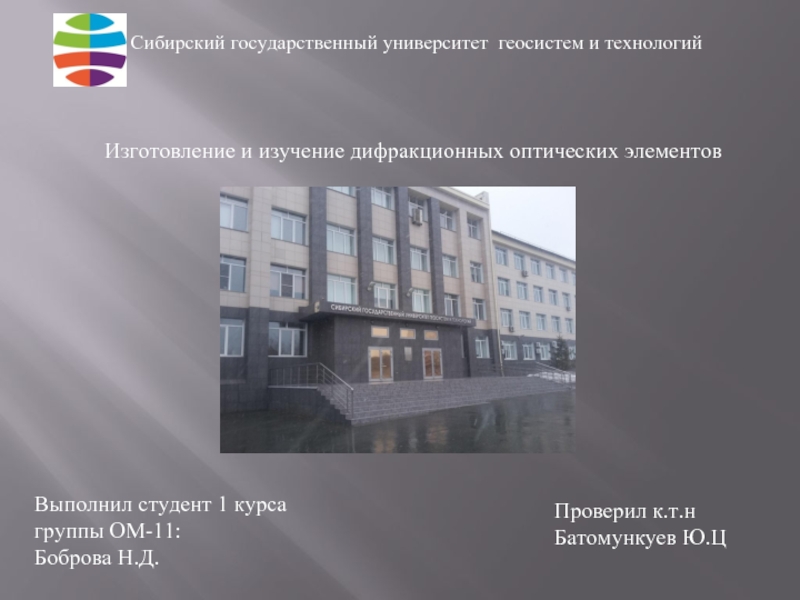- Главная
- Разное
- Дизайн
- Бизнес и предпринимательство
- Аналитика
- Образование
- Развлечения
- Красота и здоровье
- Финансы
- Государство
- Путешествия
- Спорт
- Недвижимость
- Армия
- Графика
- Культурология
- Еда и кулинария
- Лингвистика
- Английский язык
- Астрономия
- Алгебра
- Биология
- География
- Детские презентации
- Информатика
- История
- Литература
- Маркетинг
- Математика
- Медицина
- Менеджмент
- Музыка
- МХК
- Немецкий язык
- ОБЖ
- Обществознание
- Окружающий мир
- Педагогика
- Русский язык
- Технология
- Физика
- Философия
- Химия
- Шаблоны, картинки для презентаций
- Экология
- Экономика
- Юриспруденция
Radiation analysis for space GRAS презентация
Содержание
- 1. Radiation analysis for space GRAS
- 2. Giovanni Santin - GRAS - Leuven, 5
- 3. Giovanni Santin - GRAS - Leuven, 5
- 4. Giovanni Santin - GRAS - Leuven, 5
- 5. Giovanni Santin - GRAS - Leuven, 5
- 6. Giovanni Santin - GRAS - Leuven, 5
- 7. Giovanni Santin - GRAS - Leuven, 5 Oct 2005 GRAS components
- 8. Giovanni Santin - GRAS - Leuven, 5
- 9. Giovanni Santin - GRAS - Leuven, 5 Oct 2005 GRAS components
- 10. Giovanni Santin - GRAS - Leuven, 5
- 11. Giovanni Santin - GRAS - Leuven, 5
- 12. Giovanni Santin - GRAS - Leuven, 5
- 13. Giovanni Santin - GRAS - Leuven, 5
- 14. Giovanni Santin - GRAS - Leuven, 5
- 15. Giovanni Santin - GRAS - Leuven, 5
- 16. Giovanni Santin - GRAS - Leuven, 5
- 17. Giovanni Santin - GRAS - Leuven, 5
- 18. Giovanni Santin - GRAS - Leuven, 5
- 19. Giovanni Santin - GRAS - Leuven, 5
- 20. Giovanni Santin - GRAS - Leuven, 5
- 21. Giovanni Santin - GRAS - Leuven, 5
- 22. Giovanni Santin - GRAS - Leuven, 5
- 23. Giovanni Santin - GRAS - Leuven, 5
- 24. Giovanni Santin - GRAS - Leuven, 5
- 25. Giovanni Santin - GRAS - Leuven, 5
- 26. Giovanni Santin - GRAS - Leuven, 5
- 27. Giovanni Santin - GRAS - Leuven, 5
Слайд 1Geant4
Radiation Analysis
for Space
GRAS
G.Santin1, V.Ivanchenko2, R.Lindberg1, H.Evans1, P. Nieminen1, E.Daly1
1
2 PH SFT, CERN
Geant4 Space Users Workshop
Leuven, 5 Oct 2005
Слайд 2Giovanni Santin - GRAS - Leuven, 5 Oct 2005
Outline
Motivation
Description of the
GRAS as
framework for Monte Carlo analyses
Monte Carlo engine for external packages (e.g. SPENVIS)
Present status, expectations, conclusions
Слайд 3Giovanni Santin - GRAS - Leuven, 5 Oct 2005
Simulations of the
Sources
Слайд 4Giovanni Santin - GRAS - Leuven, 5 Oct 2005
Commonly used
Ready to
Good physics
3D
1D
3D
Physics
Слайд 5Giovanni Santin - GRAS - Leuven, 5 Oct 2005
The example of
Geant4-based tool
Geant4 is a “Toolkit”
Flexible, powerful, extendable,…
But intentionally “not a tool” ready for use
MULASSIS Features
1D Layered geometry via scripting
Geant4-based
Predefined physics lists
Materials by chemical formula
Interfaced to the Space Environment spectra inside the Web-based SPENVIS framework
User success
Raised the level of radiation shielding analysis in the space community
Limitations
1D geometry
Extensibility
Слайд 6Giovanni Santin - GRAS - Leuven, 5 Oct 2005
GRAS
Geant4 Radiation Analysis
Analysis types
3D
Dose, Fluence, NIEL, activation… for support to engineering and scientific design
Dose Equivalent, Equivalent Dose,… for ESA exploration initiative
SEE: PHS, LET, SEU models
Analysis independent from geometry input format
GDML, CAD, or existing C++ class, …
Pluggable physics lists
Different analyses without re-compilation
Modular / extendable design
Publicly accessible
Слайд 8Giovanni Santin - GRAS - Leuven, 5 Oct 2005
GRAS components
G4 General
SOURCE:
RADIATION ENVIRONMENT
/gps/pos/type Surface
/gps/pos/shape Sphere
...
/gps/ang/type cos
/gps/particle e-
/gps/ene/type Arb
/gps/hist/type arb
/gps/hist/point 4.000E-02 2.245E+08
...
/gps/hist/point 7.000E+00 0.000E+00
/gps/hist/inter Lin
Source
2
Слайд 10Giovanni Santin - GRAS - Leuven, 5 Oct 2005
GRAS components
RADIATION EFFECTS
/gras/analysis/dose/addModule
/gras/analysis/dose/doseB12/addVolumeID b1
/gras/analysis/dose/doseB12/addVolumeID b2
/gras/analysis/dose/doseB12/setUnit MeV
4
Analysis
At present:
Dose
Fluence
NIEL
Deposited charge
Dose equivalent
Equivalent dose
Path length
SEE
Pulse Spectrum
Charge deposit
Source monitoring
Component degradation, background
Human exploration initiatives
Components SEE
Analysis independent from geometry input mode
- GDML, or existing C++ class, …
- Open to future geometry interfaces (CAD,…)
Слайд 11Giovanni Santin - GRAS - Leuven, 5 Oct 2005
GRAS Analysis modules:
Component
Total Ionizing Dose
Also per incoming particle type, with user choice of interface
Gives event Pulse Height Spectrum
For analysis of induced signal
Units:
MeV, rad, Gy
NIEL
MULASSIS implementation
Modular approach
Several curve sets available
CERN/ROSE (p, e-, n, pi)
SPENVIS/JPL (p)
Messenger Si (p, e-)
Messenger GaAs (p, e-)
Units:
95MeVmb, MeVcm2/g MeVcm2/mg, keVcm2/g
FLUENCE
Particle type, energy, direction, time
One/Both ways
Слайд 12Giovanni Santin - GRAS - Leuven, 5 Oct 2005
Dose equivalent
ICRP-60 and
Units:
MeV, Sv, mSv, Gy, rad
New user requirements include:
planetary models (e.g. scaling of SPE fluence to other planets, magnetic field description, crustal maps)
ion physics (electromagnetics / hadronics for HZE)
biological effects (macroscopic / microscopic models)
Equivalent Dose
ICRP-60 weights
User choice of weight interface
Units:
MeV, Sv, mSv, Gy, rad
GRAS Analysis modules:
Human Exploration Initiatives
GRAS Biological effects modules
Слайд 13Giovanni Santin - GRAS - Leuven, 5 Oct 2005
GRAS Analysis modules:
Path length analysis
Event distribution of particle path length in a given set of volumes
If used with “geantinos”, it provides the geometrical contribution to the energy deposition pattern change
In a 3D model
W.r.t. a 1D planar irradiation model
SEE models
Threshold simple model implemented
Design open to more complex modeling
Coupling to TCAD will give device behavior
CAD import (on-going) will ease geometry modeling
Courtesy Sony/Toshiba
Слайд 14Giovanni Santin - GRAS - Leuven, 5 Oct 2005
GRAS Analysis modules:
Volume
To identify a volume in the geometry tree
At present implemented as the couple (name, copy No)
Volume Interface
To identify the boundary between two volumes
Couple of Volumes
Each module can have
several Volumes and
several Volume Interfaces
Different actions taken by various module types when “in volume” / “at interface”
Result output units
User choice, module type dependent
Example:
dose module “DoseB12”
Sensitive volumes:
b1 and b2
Interface (to tag particle type):
between (sat, world)
To detect secondaries created in the satellite structure
/gras/analysis/dose/addModule doseB12
/gras/analysis/dose/doseB12/addVolumeID b1
/gras/analysis/dose/doseB12/addVolumeID b2
/gras/analysis/dose/doseB12/setUnit MeV
Слайд 15Giovanni Santin - GRAS - Leuven, 5 Oct 2005
GRAS
Building blocks
1.
2. Primary generation
3. Physics
4. Modular analysis set via macros
Utility classes: UI for many useful tasks
Regions
Create new region
Assign a volume to a region
Cuts by region
Scripting examples
Visualisation
Geometry vis. options
Colour definition
Volume colour / visibility / vis.options
…
Output
Interface to AIDA tools
Histograms, tuples
ASCII output always available
Scripting
All GRAS features are available via UI:
text macro files or
Interactive UI commands
+
Слайд 16Giovanni Santin - GRAS - Leuven, 5 Oct 2005
Not satisfied…
MC analysis
Geometry via GDML
Physics, Source, Analysis via scripts
Upgrades of models / interfaces
Extend the tool
New analysis module
New interface
(to geometry / post-processing)
…
Open to collaborative development
http://geant4.esa.int
Not satisfied…
Satisfied
Слайд 17Giovanni Santin - GRAS - Leuven, 5 Oct 2005
GRAS Analysis
Modular, extendable
GRAS Run Manager
GRAS Run Action
GRAS Event Action
GRAS Stepping Action
GRAS Tracking Action
No analysis at this level
GRAS Analysis Manager
Слайд 18Giovanni Santin - GRAS - Leuven, 5 Oct 2005
Analysis Module
Easy to
Self contained analysis element
Initialization, event processing, normalization, printout ? all inside
Only one class to create/derive in case a new type of analysis is needed
No need to modify Run+Event+Tracking+Stepping actions
AIDA histogramming “per module”
G4 UI commands “per module”
Automatic module UI tree
a la GATE
/gras/analysis/dose/addModule doseCrystal
/gras/analysis/dose/doseCrystal/setUnit MeV
XXX
Analysis
Module
Слайд 19Giovanni Santin - GRAS - Leuven, 5 Oct 2005
For present Geant4
2 ways of obtaining GRAS output without discarding hours/days/months of work
Inserting C++ Geometry, Physics and/or Primary Generator classes inside GRAS
In the main gras.cc
Inserting GRAS into your existing applications
Which way is the fastest depends on existing work
Ronnie Lindberg (ESA). See talk this session
Слайд 20Giovanni Santin - GRAS - Leuven, 5 Oct 2005
Engineering tools:
GRAS as
Geometry exchange format
- GDML
- CAD / STEP
- …
Tool GUI
Geometry modeling
GRAS
Слайд 21Giovanni Santin - GRAS - Leuven, 5 Oct 2005
User Requirements
Complete tool
Available as standalone executable
No need to download and compile Geant4
Easy to integrate in existing applications
Analysis types
3D
Dose, Fluence, NIEL, activation… for support to engineering and scientific design
Dose Equivalent, Equivalent Dose,… for ESA exploration initiative
Transients: PHS, LET, SEU models
Analysis independent from geometry input mode
GDML, or existing C++ class, …
Different analyses set without re-compilation
Modular / extendable design
Source and Physics description adequate to space applications
Solar events
Cosmic rays
Слайд 22Giovanni Santin - GRAS - Leuven, 5 Oct 2005
GRAS is being
Herschel
Test beam detector study
Radiation effects to photoconductors and bolometers
JWST
Dose
Background
ConeXpress
See talk by Ronnie Lindberg
Electronic components
Rad-hardness, local shielding, etc.
Слайд 23Giovanni Santin - GRAS - Leuven, 5 Oct 2005
GRAS for
HERSCHEL
Herschel PACS
Study and test of the detector to assess glitch rate
Impact on science objectives
Simulation of the proton irradiation at Leuven, Belgium
Comparison with glitch data on-going
Need precise description of energy degraders and beam parameters
Extrapolation to detector behavior in space
GRAS Fluence
GRAS Pulse Spectrum
Слайд 24Giovanni Santin - GRAS - Leuven, 5 Oct 2005
GRAS for JWST
Instrument design phase
Radiation shielding, material choice
Secondary neutron production experiment
Beam test at PSI, Switzerland
GRAS simulation of the set-up
Time of Flight (TOF) based neutron spectrum
3D Realistic model
neutron
proton
gamma
Слайд 25Giovanni Santin - GRAS - Leuven, 5 Oct 2005
GRAS for JWST
Secondary particle production
Shielding effect on the particle flux on the detector
Cosmic Ray background
CRÈME’96 Solar Minimum
Proton simulations
Results
Fluxes onto the detector
Protons, Gammas, electrons neutrons
Deposited energy
per particle type
Слайд 26Giovanni Santin - GRAS - Leuven, 5 Oct 2005
Status
CVS repository online
http://geant4.esa.int
Code
Latest stable tag works with
Geant4 7.1
GDML 2.3
Documentation
Introduction
README file
Installation
INSTALL file
Detailed User Manual
In preparation
New analysis types
Activation, LET/SEE
On-going collaboration with QinetiQ / REAT_MS contract
Open to new collaborations
Minor improvements
Automatic normalization to real flux in space
Interface to future G4 upgrades
Dose tallying in parallel geometry
Geometrical biasing
To improve speed for local energy deposition
Analysis algorithms are ready for biasing
Web Interface inside SPENVIS
Internal geometry, GDML exchange format
Слайд 27Giovanni Santin - GRAS - Leuven, 5 Oct 2005
Conclusions
Modular, script driven
Space users oriented, but trying to be generic
Already used in the support of a number of space missions and ground beam tests
GRAS as
Ready-to-use Geant4 tool for common analysis types
Framework for Monte Carlo analyses
Monte Carlo engine for external packages
GRAS used as framework for on-going ESA contracts
REAT_MS (QinetiQ), Geant4 usability for space applications
(CAD interface, SEE analysis, Physics lists for space applications)
Open to comments / contributions for collaborative development
http://geant4.esa.int
We believe GRAS is significantly improving the Geant4 usability
Some features could be used directly by the Geant4 kernel
Related talk
Ronnie Lindberg (ESA) with extensive validation and dosimetry / physics investigations

